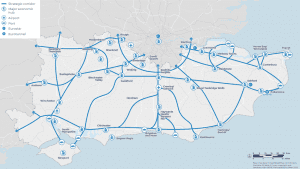 Investment could unlock massive growth, more than doubling the South East’s economy and supporting half a million new jobs by 2050
Investment could unlock massive growth, more than doubling the South East’s economy and supporting half a million new jobs by 2050- Strategy sets out bold and compelling future that is better for people, better for business and better for the planet
- Prioritising greater investment in public transport is the only feasible way to reduce congestion, cut emissions and boost air quality in the long term
People and businesses across part of the South East Local Enterprise Partnership (SELEP) area – specifically East Sussex, Kent and Medway – are being urged to have their say on a proposed 30-year transport strategy for the South East which aims to improve journeys, boost the economy and protect the environment.
The strategy outlines how, with the right investment in our region’s transport network, the South East’s economy will more than double by 2050 to between £450bn and £500bn per year – creating an additional 500,000 jobs, boosting quality of life and access to opportunities for all and helping cut the South East’s carbon emissions to net-zero.
It has been produced by Transport for the South East (TfSE), a unique partnership bringing together local authorities, business leaders and transport organisations to speak with one voice on our region’s transport priorities. TfSE covers East Sussex, Kent and Medway from the South East LEP remit, alongside Brighton & Hove, West Sussex, Surrey, Hampshire, Isle of Wight, Southampton, Portsmouth and Berkshire Local Transport Body. A separate body, Transport East, covers Essex, Southend and Thurrock from the South East LEP patch alongside Norfolk and Suffolk, and is observed by Bedford, Cambridge, Hertfordshire and Peterborough.
A major focus of the strategy is reducing the region’s reliance on private cars to reduce congestion, cut carbon emissions and improve air quality. Today, cars account for 70% of all journeys in the South East compared to just 4% by rail and 5% by bus. It also highlights how better transport links can support economic growth around our key international gateways, such as the Port of Dover and Eurotunnel, which are vital to the local, regional and national economy.
To do this, the strategy sets out a 30-year framework to guide decisions about where, when and how money is invested in the South East’s transport network, along with a range of schemes and initiatives to make sustainable travel easier and more attractive to people and businesses. These could include better and faster rail journeys, improved links to ports and airports, a real-terms freeze on rail fares, cheaper off-peak fares and extra funding to protect and enhance vital bus services.
Opportunities for the region identified in the strategy include speeding up rail journey times to London, particularly by using spare capacity on High Speed 1 and potential extension of High Speed services to East Sussex; extending Crossrail to Ebbsfleet to support new housing growth; improving road and rail links to deprived communities, particularly in coastal areas of East Sussex and Kent; and a new Lower Thames Crossing connecting Kent and Essex.
South East LEP Chair Christian Brodie said:
“Our Strategic Board spoke highly of this strategy at our most recent meeting. However, taking into consideration the split in geography for the SELEP patch, the importance of cross-region collaboration on infrastructure is even more pronounced.
“Connecting the TfSE and Transport East geographies with the Lower Thames Crossing will be of huge importance to the South East LEP area – and further afield. It is a project that must play a key role in the decisions made in the next stage of the process by TfSE, following this consultation.
“We welcome TfSE’s vision for an infrastructure-led approach, planning first and foremost for people and housing instead of just for vehicles. With substantial increases in rail and bus use forecast for the South East, developing infrastructure that suits the needs of residents – as well as international trade, thanks to the area’s role as a gateway to Europe – is a must.”
The draft transport strategy identifies priorities for future investment by looking at the challenges people and businesses will face in moving around the region and the opportunities these present to support sustainable economic growth.
These include a range specific schemes as well as wider policies and initiatives. For example, the strategy argues for greater use of new and emerging technology such as connected autonomous vehicles (CAVs) to boost connectivity. It makes the case for policy changes to enable more joined up planning, particularly between transport and housing, to help reduce the need to travel and build more sustainable communities. And the strategy also recognises that tough decisions will need to be made about how, not if, we manage demand on the busiest parts of our transport networks.
The final transport strategy is due for publication in April 2020, with a strategic investment plan planned for publication in 2021. This will provide a prioritised, costed and deliverable list of schemes, initiatives and policies to start turning the South East’s vision into reality.
Have your say
To read the draft transport strategy and take part in the consultation, go to tfse.org.uk/transport-strategy. The deadline for responses is Friday 10th January 2020.